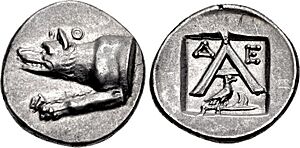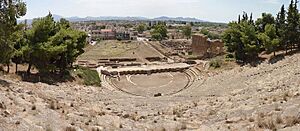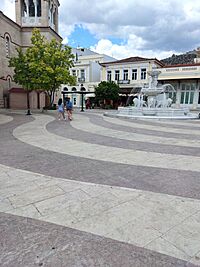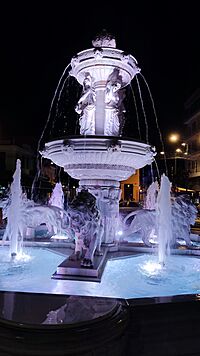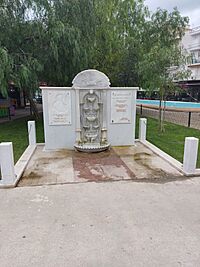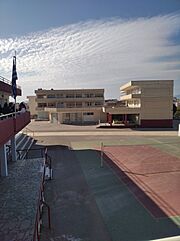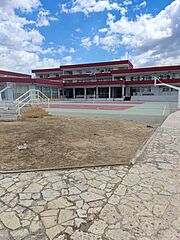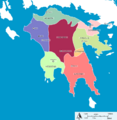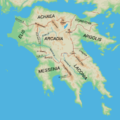Argos, Peloponnese facts for kids
Quick facts for kids
Argos
Άργος
|
||
|---|---|---|
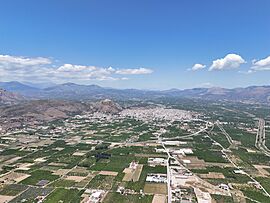
Panoramic view of Argos
|
||
|
||
| Country | Greece | |
| Administrative region | Peloponnese | |
| Regional unit | Argolis | |
| Municipality | Argos-Mykines | |
| • Municipal unit | 138.138 km2 (53.335 sq mi) | |
| Elevation | 40 m (130 ft) | |
| Population
(2021)
|
||
| • Municipal unit | 26,069 | |
| • Municipal unit density | 188.717/km2 (488.775/sq mi) | |
| Community | ||
| • Population | 21,891 (2021) | |
| Time zone | UTC+2 (EET) | |
| • Summer (DST) | UTC+3 (EEST) | |
| Postal code |
21200
|
|
| Area code(s) | 2751 | |
| Vehicle registration | AP | |
Argos (pronounced AR-gos) is a historic city in Argolis, Peloponnese, Greece. It is one of the oldest cities in the world where people have lived without interruption for thousands of years. In fact, it's one of the oldest in Europe!
Argos is the biggest city in Argolis. It has almost twice as many people as Nafplio, which is the capital of the region. Since 2011, Argos has been part of the larger Argos-Mykines municipality.
People from Argos are called Argives. This name was also used in ancient times for the Greeks who fought in the Trojan War.
Today, you can find many ancient buildings and monuments in Argos. The main way people make a living here is through farming.
Contents
What's in a Name?
The name Argos might come from an ancient king named Argus. He was the third king of the city and supposedly renamed it after himself.
The word "Argos" is also linked to an old Greek word meaning "white" or "shining." This might describe how the plains around Argos looked during harvest time. Some think the name could even come from a word meaning "field."
A Journey Through Time
Ancient Argos
Argos has a very long history. It's believed to be the origin of the royal family of ancient Macedonia, which included famous kings like Philip II and Alexander the Great.
Argos was a very important city during the Mycenaean era. This was a time when powerful kingdoms thrived in Greece, known for their strong palaces and rich culture.
In later classical times, Argos was a strong rival to Sparta. They both wanted to be the most powerful city in the Peloponnese. However, Argos chose to stay neutral during the Greco-Persian Wars against the Persians. This made other Greek cities less friendly towards Argos.
People have lived in Argos continuously for about 7,000 years! It started as a small village on Aspida hill. The city is in a great location, close to other important places like Nemea and Corinth. It also used to be near a lake called Lerna.
Powerful Archaic Period
Argos became very strong and expanded a lot under King Pheidon in the 7th century BC. He helped Argos take control over nearby cities and challenge Sparta's power.
Argive soldiers even defeated the Spartans in a battle around 669 BC. During this powerful time, Argos was known for its pottery, bronze sculptures, and clothing. They also had many festivals and a market for local goods. King Pheidon even took control of the Olympic Games for a while!
Classical Challenges
In 494 BC, Argos suffered a big defeat against Sparta. This led to political changes, and Argos became a democracy. However, Argos did not join the Greek alliance against the Persian invasion in 480 BC, which made it somewhat isolated.
Later, Argos teamed up with Athens and Thessaly, but this alliance didn't last long. Argos tried to lead an alliance against Sparta and Athens in 421 BC, but they lost a major battle. This weakened Argos and caused some political problems.
Argos played a smaller role in later wars. For a short time, it even considered joining with Corinth to form a bigger state, but this didn't work out. Argos remained a less powerful city in Greek affairs after this.
Even though Argos was attacked by Pyrrhus of Epirus in 272 BC (where Pyrrhus was killed), it managed to avoid being taken over by Macedon during the time of Philip II and Alexander the Great.
Democracy in Action
Argos was a democracy for most of the classical period. This means citizens had a say in how the city was run. Democracy began after a big defeat by the Spartans in 494 BC. So many Argives died that a revolution happened, and more people were allowed to participate in the government.
Argive democracy had an Assembly, a Council, and another group called 'The Eighty'. Leaders served for six months and were checked to make sure they did a good job.
Roman and Byzantine Times
Under Roman rule, Argos was part of the Achaea province. It was a successful city, but like much of Greece, it faced problems in the 3rd century AD. In 267 AD, groups like the Goths attacked and damaged many Greek cities, including Argos.
Later, in 396–397 AD, the Visigoths also attacked Greece, causing more damage. Many parts of Argos were destroyed. In the late 7th century, Argos became part of the Byzantine Empire.
Crusader and Ottoman Rule
After the Fourth Crusade, Christian knights from Europe took over the castle on Larisa Hill. The area became part of a new lordship. In 1388, it was sold to the Republic of Venice, but then taken by a Greek ruler before Venice could fully control it. Venice eventually bought it in 1394.
Venetian rule lasted until 1463, when the Ottoman Empire took over the city. In 1397, the Ottomans plundered Argos and took some people away as slaves. The Venetians brought in new settlers to help rebuild the town.
During Ottoman rule, Argos was divided into four neighborhoods. The city grew a lot during this time, but without much planning. Streets were often long and winding, with narrow alleys. You can still see some of this old layout in Argos today.
Modern History
Argos remained under Ottoman control until the Greek War of Independence began in 1821. During the war, local governments were formed, and the "Consulate of Argos" was declared.
After Greece gained independence, Governor Ioannis Kapodistrias tried to modernize Argos. He wanted to create a city plan with wide streets and public spaces. However, these plans were not fully put into action.
There were even discussions about making Argos the new capital of Greece instead of Nafplio or Athens. Supporters said Argos was naturally protected and had a nearby port. But in the end, Athens became the capital in 1834.
During World War II, Argos airfield was bombed by Allied forces on October 14, 1943. This caused about 100 deaths in the city.
Mythology and Legends
Argos is famous in Greek mythology. Many legendary kings ruled here, including Inachus, Phoroneus, and Danaus.
The city is also believed to be the birthplace of the hero Perseus. He was the son of the god Zeus and Danaë, who was the daughter of King Acrisius of Argos.
After the first 17 kings, Argos was sometimes ruled by three kings at once. Later, the kingdom was reunited under Cyanippus.
Church History
Christianity came to Argos a long time ago. The first known bishop, Genethlius, lived in 448 AD. Later bishops from Argos attended important church meetings. Today, the local church is part of the Greek Orthodox faith.
During the time of the Crusaders, Argos also had a Latin Church bishopric from 1212 until the Ottomans took over.
City Life
Where is Argos?
Argos is bordered by the Xerias river to the north and the Inachos river to the east. To the west are Larissa Hill, with its castle and a monastery, and Aspida Hill.
The main town center is Agios Petros (Saint Peter) square, with its cathedral. Other important squares include Laiki Agora (Open Market) square, where a market is held twice a week, and Dikastirion (Court) square. Bonis Park is a nice green space in the city.
The busiest streets for shopping are around Agios Petros square and Korinthou street. The pedestrian streets are popular meeting spots with many shops and cafes.
In 2022, a new statue of Heracles was put up in Argos. It's a copy of a famous ancient statue. Also, a large fountain with lions and figures of the Danaids was completed in St. Peter's square in March 2022.
The city has three monasteries located on Larissa hill.
How Many People Live Here?
In 700 BC, about 5,000 people lived in Argos. By the 4th century BC, the population grew to as many as 30,000!
Today, according to the 2021 census, Argos has a population of 21,891 people. It is the largest city in Argolis, even bigger than the capital, Nafplio.
What About the Economy?
Farming is the most important economic activity in Argos. Farmers grow a lot of citrus fruits, olives, and apricots. Argos is also known for its special local melon variety. There are also factories that process fruits and make dairy products.
The ancient and medieval ruins in Argos are a big draw for tourists.
Amazing Monuments
Many of Argos' historical and archaeological sites are still being preserved or renovated:
- The Larisa castle was built in prehistoric times. It has been repaired and expanded many times over the centuries. It played a key role during the Venetian rule and the Greek War of Independence. It sits on top of Larissa Hill, the highest point in the city.
- The ancient theatre was built in the 3rd century BC and could hold 20,000 people! It replaced an older theatre and was connected to the ancient agora. Today, cultural events are held there in the summer.
- The ancient agora, next to the theatre, was the main public space in ancient Argos. It had a council building (bouleuterion), a sanctuary, and a training ground for athletes.
- The "Criterion" of Argos is an ancient monument at the foot of Larissa hill. It was an ancient court, similar to the Areopagus in Athens. Later, it became a fountain.
- The Barracks of Kapodistrias is a historic building. Built in the 1690s as a hospital, it later served as a market, post office, and cavalry barracks. It was even used as a school and a refugee shelter. Today, it houses the Byzantine Museum of Argos.
- The Municipal Neoclassical Market building, built in 1889, is a beautiful example of modern Argos architecture. It has arches and houses small shops.
- The Kapodistrian school, built in 1830, was part of Kapodistrias' efforts to provide education. Today, this neoclassical building is the 1st elementary school in town.
- The old Town Hall, built in 1830, served many purposes, including a court and a prison. It was the town hall until 2012.
- The house of Spyridon Trikoupis, a famous politician, was built in 1900.
- The temple of Agios Konstadinos is one of the few remaining buildings from the Ottoman era. It was built around 1570–1600 and used to be a mosque before becoming a Christian church.
- The Hellinikon Pyramid dates back to the late 4th century BC. Its purpose is still debated, with some theories suggesting it was a tomb or a fortress.
Many archaeological finds from Argos are displayed at the Argos museum, located in the old building of Dimitrios Kallergis at Saint Peter's square.
Getting Around
Argos has regular bus services connecting it to nearby areas and Athens. You can also find taxi stands in the main squares. The city has a good road network that links it to other towns and the rest of Greece.
Argos also has a railway station. Currently, train services in the Peloponnese are stopped, but there have been talks about reopening the line.
Learning in Argos
Argos has many schools for students of all ages. This includes seven primary schools, four junior high schools, three senior high schools, a vocational school, and a music school. There are also two public libraries for children and young people.
Sports in Argos
Argos is home to two main sports clubs:
- Panargiakos F.C. is a football (soccer) club founded in 1926.
- AC Diomidis Argous is a handball club founded in 1976. They have won national and European titles!
The city also has a municipal sports center, an indoor gym, and a municipal swimming pool that opened in May 2021.
| Sport clubs based in Argos | |||
|---|---|---|---|
| Club | Founded | Sports | Achievements |
| Panargiakos F.C. | 1926 | Football | Earlier presence in Alpha Ethniki |
| AC Diomidis Argous | 1976 | Handball | Panhellenic and European titles in Greek handball |
Famous People from Argos
Many notable people are linked to Argos, including:
- Acrisius, a mythological king
- Perseus, a famous hero from mythology
- Agamemnon, the legendary leader of the Achaeans in the Trojan War
- Pheidon, a powerful king of Argos in the 7th century BC
- Polykleitos, a famous sculptor from the 5th–4th century BC
- Telesilla, a Greek poet from the 6th century BC
Sister Cities
Argos has "twin town" or "sister city" relationships with other cities around the world. This helps them share culture and ideas.
See Also
- Argos (dog)
- Communities of Argos (municipal unit)
- Kings of Argos
- List of ancient Greek cities
- List of settlements in Argolis
Images for kids




